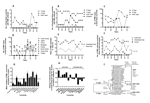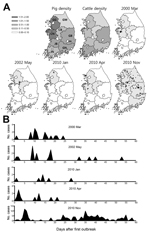Volume 20, Number 12—December 2014
Dispatch
Reemergence of Foot-and-Mouth Disease, South Korea, 2000–2011
Abstract
Five outbreaks of foot-and-mouth disease have occurred in South Korea during 2000–2011. Macro-analysis of these outbreaks showed a correlation with outbreaks in countries in eastern Asia. Genetic analyses of food-and-mouth disease viruses in South Korea showed a correlation with viruses that are prevalent in neighboring countries.
Foot-and-mouth disease is an infectious viral disease that occurs in animals and is easily transmissible. Outbreaks of this disease affect international trade (1). Since 2000, five outbreaks (in March 2000, May 2002, January 2010, April 2010, and November 2010–April 2011) have occurred in South Korea; the outbreak in 2000 was the first in 66 years (2–8).
To better understand the risks associated with reemergence of this disease in South Korea, we examined characteristics of these outbreaks and those occurring in neighboring countries by using macroscopic analysis. We describe the outbreak patterns to enable prediction and prevention of this disease in South Korea.
Spatiotemporal analyses used data obtained from the World Organisation for Animal Health Information Database (http://www.oie.int), the Food and Agriculture Organization World Reference Laboratory for foot-and-mouth disease (http://www.wrlfmd.org), the Southeast Asia and China Foot-and-Mouth Disease Campaign (http://www.seafmd-rcu.oie.int), national reports for international meetings (Southeast Asia and China Foot-and-Mouth Disease Campaign 2013, World Organisation for Animal Health/Japan Trust Fund on foot-and-mouth disease control in Asia 2013), and previously reported data (9–11) for Southeast Asia (Vietnam, Cambodia, Myanmar, Thailand, Laos, Malaysia, and the Philippines) and eastern Asia (South Korea, Japan, China, Mongolia, Russia, North Korea, Hong Kong, and Taiwan) regions for 1999–2013. Statistical analysis was performed by using paired or unpaired t-tests, and correlation were made by using GraphPad InStat version 3.05 (Graph Pad Software, La Jolla, CA, USA). A phylogenetic tree was inferred by using the neighbor-joining method, and analysis was conducted by using MEGA version 6 (http://www.megasoftware.net/).
Comparative analysis of outbreaks in neighboring countries over the past 15 years showed a high incidence of outbreaks at 2- to 5-year intervals (2000, 2005, 2010–2011, and 2013) (Figure 1, panels A and F). Analysis of outbreak serotypes and cases in neighboring countries (Figure 1, panels A–C) showed that type O foot-and-mouth disease virus has been predominant every year for the past 15 years. Outbreaks in eastern Asia and South Korea over the past 15 years showed a strong relationship with each other (r = 0.725) (Figure 1, panels D–H). Given the overall trend in Asia, serotype Asia 1 was predominant in 2005 (Figure 1, panels A, B). The situation for foot-and-mouth disease in Asia was regarded as serious during 2010–2011 because of the increased numbers of outbreaks (Figure 1, panels A, C–F). In 2013, the number of type A outbreaks increased, and outbreaks caused by types O and A viruses were still considered a threat (Figure 1, panels A, B).
Of 5 outbreaks in South Korea during 2000–2011, 4 were caused by type O virus, 2 were caused by the Middle East–South Asia topotype, and 2 were caused by the Southeast Asia topotype. One of the 5 outbreaks was caused by type A virus (ASIA topotype, Sea-97 lineage) (Table; Figure 1, panel I). Middle East–South Asia topotype viruses that caused outbreaks in 2000 and 2002 were related to PanAsia lineage viruses, which were detected during 1999–2000 in China, Taiwan, Japan, and Thailand; the causative viruses had high genetic similarity (12). We assume that these viruses, which have predominated in these regions since 1998 (12), were introduced to South Korea in 2000 and 2002. Serotype O viruses that caused outbreaks in 2010 were identified as SEA type, Mya-98 lineage. This virus type was detected in 2010 in Asia, including Russia, Japan, China, Hong Kong, and Vietnam, and the genetic similarity of these viruses was high (Figure 1, panel I). Type A virus (ASIA topotype, Sea-97 lineage) was detected in South Korea in January 2010. This virus is similar to those detected in 2009 in China and Vietnam. Genetic analyses of all viruses detected in South Korea showed a correlation with viruses that predominated in neighboring countries (Figure 1, panel I).
Major putative factors for inter-regional or inter-farm virus transmission during the 5 foot-and-mouth disease outbreaks in South Korea were movement of humans or vehicles (Table). The 5 outbreaks that occurred since 2000 were analyzed by province (Figure 2, panel A). The disease occurred most frequently in Gyeonggi Province (5 times), followed by Chungbuk Province (4 times) and Chungnam Province (3 times). Therefore, these 3 provinces, which had the highest risk for infection, were characterized by a high density of pig and cattle farms. On the basis of analysis of 4 outbreaks, the second round of outbreaks occurred 8.0 ± 2.0 days after the first infected group had been identified (Figure 2, panel B). In the most recent outbreak in November 2010, the initial diagnosis was delayed for 1 week; many concurrent infections were detected, and no unique aspects of transmission after the first detection of the disease had been identified (Figure 2, panel B). Most infections occurred ≤25 days after the initial case, after which occurrence was intermittent (Figure 2, panel B).
International trade and globalization have recently been indicated as major factors for transmission of infectious diseases associated with livestock (6). Multiple sources of serotypes O, A, and Asia 1 of foot-and-mouth disease viruses, which have caused recent outbreaks in eastern Asia, are endemic to Southeast Asia (13). Incursion of these viruses from Southeast Asia into eastern Asia has been suggested because of the porous nature of borders (13). However, the Korean Peninsula is surrounded by water on 3 sides and shares its only land border with North Korea. We believe that inflow of illegal live animals and livestock products, which is generally the highest risk factor for foot-and-mouth disease (14), is negligible in the regions around South Korea. Access to suspected infectious materials from countries with outbreaks is fundamentally blocked by shipping regulations.
Although no evidence for confirmation of introduction is available, results of epidemiologic investigations have indicated that the 5 foot-and-mouth disease outbreaks in South Korea were related primarily to indirect transmission by humans who came into contact with suspected infectious animals or livestock products from countries in Asia to which the virus is endemic (Table) (2–7). In addition, imported hay or other imported animal products were probable sources of virus in March 2000 and January 2010 (Table) (2,4,8), and the viruses were transmitted to persons who had contact with these materials directly or indirectly. On the basis of the national mandatory reporting system for foreign workers (http://www.kahis.go.kr), we found that the number of persons from Vietnam, Cambodia, Thailand, and China who work on farms in South Korea has been increasing since 2005. The recent situation can be regarded as conducive for an increased risk for foot-and-mouth disease.
The outbreak pattern of foot-and-mouth disease in South Korea was more strongly correlated with outbreaks in countries in eastern Asia than with outbreaks in Southeast Asia. Outbreaks every 15 years caused by type O foot-and-mouth disease virus are predominant in Asia. The greatest risk for infection is currently by type O and A viruses, followed by type Asia 1 virus.
In summary, type O foot-and-mouth disease virus was responsible for 4 outbreaks in South Korea and type A virus accounted for 1 outbreak. South Korea might be at risk for foot-and mouth disease, given the high incidence of this disease at 2- to 5-year intervals (2000, 2005, 2010–2011, and 2013) in eastern Asia. Foot-and-mouth disease outbreaks in neighboring countries were a probable major source of introduction of this disease into South Korea. Once this disease is introduced, prevention of domestic transmission should include extensive restriction of movement of humans or vehicles during an outbreak.
Dr Park is a research scientist at the Animal and Plant Quarantine Agency, Gyeonggi-do, South Korea. His research interests are diagnosis and surveillance of foot and mouth disease, and development of vaccines and antiviral agents against this disease.
Acknowledgments
We thank the staff of the Animal and Plant Quarantine Agency for providing assistance during the study.
This study was supported by a grant from the Animal and Plant Quarantine Agency National Animal Disease Research Project.
References
- Callis JJ. Evaluation of the presence and risk of foot and mouth disease virus by commodity in international trade. Rev Sci Tech. 1996;15:1075–85 .PubMedGoogle Scholar
- Sakamoto K, Yoshida K. Recent outbreaks of foot and mouth disease in countries of east Asia. Rev Sci Tech. 2002;21:459–63 .PubMedGoogle Scholar
- Wee SH, Yoon H, More SJ, Nam HM, Moon OK, Jung JM, Epidemiological characteristics of the 2002 outbreak of foot-and-mouth disease in the Republic of Korea. Transbound Emerg Dis. 2008;55:360–8. DOIPubMedGoogle Scholar
- Park JH, Lee KN, Ko YJ, Kim SM, Lee HS, Park JY, Diagnosis and control measures of the 2010 outbreak of foot-and-mouth disease A type in the Republic of Korea. Transbound Emerg Dis. 2013;60:188–92. DOIPubMedGoogle Scholar
- Park JH, Lee KN, Ko YJ, Kim SM, Lee HS, Shin YK, Control of foot-and-mouth disease during 2010–2011 epidemic, South Korea. Emerg Infect Dis. 2013;19:655–9. DOIPubMedGoogle Scholar
- Park JH, Lee KN, Ko YJ, Kim SM, Lee HS, Park JY, Outbreaks and diagnosis of foot-and-mouth disease serotype O in the Republic of Korea, April–June 2010. Transbound Emerg Dis. 2014;61:277–84. DOIPubMedGoogle Scholar
- Yoon H, Yoon SS, Kim YJ, Moon OK, Wee SH, Joo YS, Epidemiology of the foot-and-mouth disease serotype O epidemic of November 2010 to April 2011 in the Republic of Korea. Transbound Emerg Dis. 2013. [Epub ahead of print].
- Shin JH, Sohn HJ, Choi KS, Kwon BJ, Ko YJ, An DJ, Molecular epidemiological investigation of foot-and-mouth disease virus in Korea in 2000. J Vet Med Sci. 2003;65:9–16. DOIPubMedGoogle Scholar
- Di Nardo A, Knowles NJ, Paton DJ. Combining livestock trade patterns with phylogenetics to help understand the spread of foot and mouth disease in sub-Saharan Africa, the Middle East and Southeast Asia. Rev Sci Tech. 2011;30:63–85 .PubMedGoogle Scholar
- Valdazo-González B, Timina A, Scherbakov A, Abdul-Hamid NF, Knowles NJ, King DP. Multiple introductions of serotype O foot-and-mouth disease viruses into east Asia in 2010–2011. Vet Res. 2013;44:76. DOIPubMedGoogle Scholar
- Madin B. An evaluation of foot-and-mouth disease outbreak reporting in mainland South-East Asia from 2000 to 2010. Prev Vet Med. 2011;102:230–41 . DOIPubMedGoogle Scholar
- Knowles NJ, Samuel AR, Davies PR, Midgley RJ, Valarcher JF. Pandemic strain of foot-and-mouth disease virus serotype O. Emerg Infect Dis. 2005;11:1887–93. DOIPubMedGoogle Scholar
- Knowles NJ, He J, Shang Y, Wadsworth J, Valdazo-Gonzalez B, Onosato H, Southeast Asian foot-and-mouth disease viruses in eastern Asia. Emerg Infect Dis. 2012;18:499–501. DOIPubMedGoogle Scholar
- Pharo HJ. Foot-and-mouth disease: an assessment of the risks facing New Zealand. N Z Vet J. 2002;50:46–55 . DOIPubMedGoogle Scholar
Figures
Table
Cite This ArticleTable of Contents – Volume 20, Number 12—December 2014
| EID Search Options |
|---|
|
|
|
|
|
|


Please use the form below to submit correspondence to the authors or contact them at the following address:
Jong-Hyeon Park, Animal and Plant Quarantine Agency, 175 Anyang-ro, Manan gu, Anyang City, Gyeonggi-do 430-757, South Korea
Top